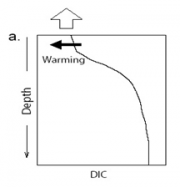The Southern Ocean carbon cycle response to future climate change
- This page is part of the topic Antarctic climate and environment change over the next 100 years
Contents
Background
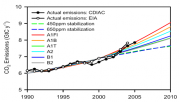
Atmospheric CO2 emissions continue to increase at unprecedented rates. Already emissions have equalled or exceeded the previous worst-case scenarios for the IPCC (Raupach et al., 2007[1]; Figure 5.21). Currently it is estimated that about 30% of the CO2 emitted annually is taken up by the ocean (Sabine et al., 2004[2]). The Southern Ocean plays a critical role in taking up this CO2, with more than 40% of the annual mean uptake of atmospheric CO2 being taken up in the region south of 40°S (Takahashi et al., 2009[3]). Clearly then the way in which the Southern Ocean responds to climate change will directly impact global atmospheric CO2 levels and hence the rate of the earth’s warming. Hence, determining the role of the Southern Ocean in CO2 exchange must be a priority if we are to formulate effective global policies for stabilizing atmospheric CO2 levels.
Future Southern Ocean carbon response
Response to increased winds
As the Southern Ocean becomes windier in response to global warming there will be an associated increase in the upwelling of carbon-rich water from the deep ocean. As this upwelled carbon reaches the surface it will increase the CO2 content of surface water, reducing the pCO2 gradient between the atmosphere and the ocean, and hence the uptake of CO2 by the ocean from the atmosphere (Zickfeld et al., 2007[4]). At the same time atmospheric CO2 concentrations will continue to rise in response to human activities. Eventually, as the atmospheric concentration of CO2 exceeds the maximum deep-water pCO2 value, estimated to be 430 microatmospheres (μatm) (McNeil et al., 2007[5]), the Southern Ocean CO2 sink will then change from a saturated CO2 sink (Le Quéré et al., 2007[6]) to a strengthening CO2 sink. Model simulations suggest that this change will take place in the period 2020-2030 (under the IPCC A2 emission scenario) (Matear and Lenton, 2008[7]; Zickfeld et al., 2008[8]).
Response to ocean warming
As the Southern Ocean becomes warmer, its ability to store CO2 through solubility changes is affected. Freshening associated with the warming will lead to a stratification of the upper ocean that will affect ocean carbon uptake through biogeochemical and physical changes. Warming will reduce the solubility of CO2 in seawater, so reducing the ocean’s ability to take up and store CO2 (Figure 5.22a). A warming of 1% decreases oceanic pCO2 by 4.23% (Takahashi et al., 1993[9]). The result of these solubility changes will be to reduce the pCO2 gradient between the atmosphere and the ocean, reducing the efficiency of ocean CO2 uptake. Various studies of future CO2 uptake suggest that the solubility effect will be significant (Matear and Hirst, 1999[10]; Plattner et al., 2001[11]; Sarmiento et al., 1998[12]), although its magnitude remains poor quantified.
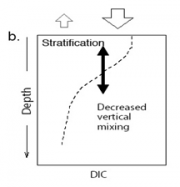
The Southern Ocean is a high nutrient low chlorophyll (HNLC) region rich in the macronutrients (nitrogen, phosphate and silicate) needed by phytoplankton to grow, but poor in phytoplankton, most likely due to a lack of micronutrients, in particular iron. It also suffers from the low levels of light at high latitude, which may inhibit productivity. As the upper ocean warms, freshens and stratifies, conditions will favour an increase in productivity. That in turn will use up CO2 in surface waters, which will increase the ocean – atmosphere pCO2 gradient, thereby encouraging more uptake of CO2 by the ocean from the atmosphere (Figure 5.22b). Increasing stratification of the surface ocean will also tend to limit the supply of nutrients from below, hence limiting productivity and increasing the uptake of CO2. The amount of nutrients available in the stratified surface waters, hence productivity and CO2 uptake, will also depend on the efficiency with which organic matter is exported out of the mixed layer by sinking (Figure 5.22b).
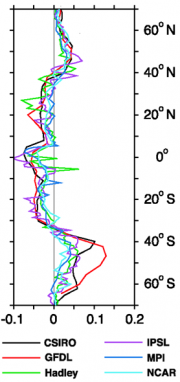
Bopp et al. (2001[15]) explored the relationship between the different competing processes in a coupled climate carbon model and showed that because the Southern Ocean was nutrient-limited, the largest effect was from stratification, which increased the interaction between light and nutrients and led to a longer and more efficient growing season with a 30% increase in marine productivity and export production. Consistent with this, Sarmiento et al. (2004b[13]) found that six different coupled climate carbon models showed increased primary production in the Southern Ocean between now and 2060 (Figure 5.23). The magnitude of the response was highly correlated with the strength of stratification, which in turn was related to changes in sea ice extent forced by continued global warming.
In addition to inducing biogeochemical changes, increased ocean stratification may also reduce uptake of CO2 from the atmosphere through Southern Ocean density changes. Mignone et al. (2006[16]) showed that the depth of the pycnocline is highly correlated with CO2 uptake. As a result it is predicted that as stratification increases the pycnocline will shallow, so further reducing CO2 uptake (Sarmiento et al., 1998[12]).
Response to increased CO2 uptake
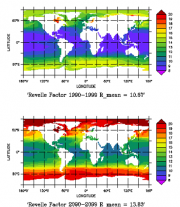
The uptake of CO2 by the Southern Ocean alters ocean carbonate chemistry, causing both a reduction in ocean pH (i.e. acidification) and a reduction in the ocean’s ability to take up and store CO2 through an increase in the Revelle Factor. The Revelle factor (Revelle and Suess, 1957[18]), or buffer capacity, describes by how much the concentration of CO2 in the ocean will change for a given increase in the partial pressure of CO2 (pCO2). The higher the Revelle (or buffer) Factor, the less able the ocean is to take up atmospheric CO2. As shown in Figure 5.24, the Revelle factor in the Southern Ocean lies between 10 and 15. In the next 100 years it is predicted to increase to 17 or more, which will reduce the efficiency of the ocean to take up atmospheric CO2.

As the CO2 levels in the ocean increase, the associated changes in ocean carbonate chemistry will lower the pH. Currently the upper ocean is supersaturated with respect to aragonite (used by important grazers like pteropods), and calcite (used by coccolithophores). As the ocean becomes more acidic (lower pH), the saturation states of both aragonite and calcite will be reduced until they drop below 1, when they pass through the saturation horizon - the point where the saturation state changes from super- to under-saturated. When the waters become under-saturated with respect to either aragonite or calcite it will no longer be possible for marine organisms to use these compounds to build calcium carbonate shells (Feely et al., 2004[20]). Orr et al. (2005[19]) used a suite of ocean models to show that by 2100 the saturation horizon will have shallowed significantly, the pH having dropped by an additional 0.3, and hence much of the Southern Ocean will be under-saturated with respect to aragonite (Figure 5.25). This acidification is expected to bring about a shift in marine ecosystems (Feely et al., 2004[20]), and potentially a reduction in export production (Klaas and Archer, 2002[21]), although it has been suggested that this effect may be offset by increased CO2 uptake causing an increase in alkalinity (Heinze, 2004[22]).
While mean long-term changes in acidification and the Revelle Factor are significant, they are subject to large interannual variability (Matear and Lenton, 2008[7]). This variability has the potential to perturb the system significantly, such that far reaching changes in the ocean ecosystem may occur well in advance of those expected by simply increasing CO2 levels.
Studies of the global uptake of CO2 from the ocean by the atmosphere suggest that over time the ocean will release sufficient CO2 to amplify global warming (a positive feedback). As we have seen here the Southern Ocean is expected to evolve to act as a net sink for CO2 over the next 100 years (a negative feedback). Nevertheless, the eventual behaviour of the Southern Ocean will depend not only on what happens around Antarctica, but also on what happens in the terrestrial biosphere. Changes in the uptake of CO2 from the atmosphere by the terrestrial biosphere, particularly at mid-latitudes, could be large enough to change the pCO2 gradient between the atmosphere and the ocean, thereby affecting the response of the Southern Ocean.
Concluding remarks
The magnitude of the response of the Southern Ocean to climate change remains uncertain. Simulations from coupled climate carbon models show a large range of responses (e.g. Friedlingstein et al., 2006[17]), but do agree that the Southern Ocean will be an increased sink of atmospheric CO2 in the future and that the recent reduction in CO2 uptake will not continue. The magnitude of the total uptake is dependent on how the ocean responds to predicted increases in ocean warming and stratification, which can drive both increases in CO2 uptake through biological and export changes, and decreases through solubility and density changes. The expected increased ventilation of carbon-rich deep water, combined with uptake of atmospheric CO2, will increase the carbon content of the upper ocean, reducing the Southern Ocean’s ability to take up more CO2 in the future (through the Revelle or buffer Factor) and enhancing ocean acidification. This acidification is potentially worrisome because of its potential to impact the entire marine ecosystem. The various projections of future response are based primarily on coupled climate-carbon simulations, but such predictions need to be validated. It is therefore extremely important that strategies be developed to observe and detect change in the ocean carbon system (e.g. Lenton et al., 2006[23], 2009[24]) to complement ongoing and planned physical measurements e.g. by Argo floats.
References
- ↑ 1.0 1.1 Raupach, M., ET AL. 2007, Global and regional drivers of accelerating CO2 emissions, Proc. Nat. Acad. Sci., 104, no. 24 10288-10293.
- ↑ Sabine, C.L., ET AL. 2004. The Oceanic Sink for Anthropogenic CO2, Science, 305, 367-371.
- ↑ Takahashi, T., Sutherland, S.C., Wanninkhof, R., Sweeney, C., Feely, R.A., Chipman, D.W., Hales, B., Friederich, G., Chavez, F., Sabine, C., Watson, W., Bakker, D.C.E., Schuster, U., Metzl, N., Yoshikawa-Inoue, H., Masao Ishii, M., Midorikawa, T., Nojiri, Y., Kortzinger, A., Steinhoff, T., Hoppema, M., Olafsson, J., Thorarinn, S.., Arnarson, T.S., Tilbrook, B., Johannessen, T., Olsen, A., Bellerby, R., Wong, C.S., Delille, B., Bates, N.R. and De Baar, H.J.W. 2009. Climatological mean surface PCO2 and net CO2 flux over the global oceans, Deep Sea Research, doi:10.1016/dsr2.2008.12.009.
- ↑ Zickfeld, K., Fyfe, J.C., Saenko, O.A., Eby, M. and Weaver, A.J. 2007. Response of the global carbon cycle to human-induced changes in Southern Hemisphere winds, Geophysical Research Letters, 34, L12712 doi:10.1029/2006GL028797
- ↑ McNeil, B.I., Metzl, N., Key, R.M., Matear R.J. and Corviere, A. 2007., An empirical estimate of the Southern Ocean air-sea CO2 flux, Global Biogeochemical Cycles, 21(3), GB03011, doi:10.1029/2007GB002991
- ↑ Le Quéré, C., Rodenbeck, C., Buitenhuis, E.T., Conway, T.J., Langenfelds, R., Gomez, A., Labuschagne, C., Ramonet, M., Nakazawa, T., Metzl, N., Gillett, N. and Heimann, M. 2007. Saturation of the Southern Ocean CO2 Sink Due to Recent Climate Change, Science, 316, 1735-1738, doi: 10.1126/science.1136188.
- ↑ 7.0 7.1 Matear, R.J. and Lenton, A. 2008. Impact of Historical Climate Change on the Southern Ocean Carbon Cycle, Journal of Climate, 21, 5820-5834, doi: 10.1175/2008JCLI2194.1.
- ↑ Zickfeld, K., Fyfe, J.C., Eby, M. and Weaver, A.J. 2008. Comment on "Saturation of the Southern Ocean CO2 Sink due to Recent Climate Change", Nature, 570b.
- ↑ Takahashi, T., Olafsson, J., Goddard, J.G., Chipman, D.W. and Sutherland, S.C. 1993. Seasonal variation of CO2 and nutrients in the high-latitude surface oceans: a comparative study, Global Biogeochemical Cycles, 7, 843-878.
- ↑ Matear, R.J. and Hirst, A.C. 1999. Climate change feedback on the future oceanic CO2 uptake, Tellus, 51B, 722-733.
- ↑ Plattner, G.K., Joos, F., Stocker, T.F. and Marchal, O. 2001. Feedback Mechanisms and sensitivities of ocean carbon uptake under global warming, Tellus B, 53, 564-592.
- ↑ 12.0 12.1 Sarmiento, J.L., Hughes, T.M.C., Stouffer, R.J. and Manabe, S. 1998. Simulated response of the ocean carbon cycle to an anthropogenic climate warming, Nature, 393, 245-249.
- ↑ 13.0 13.1 Sarmiento, J.L., Slater, R., Barber, R.T., Bopp, L., Doney, S.C., Hirst, A.C., Kleypas, J., Matear, R.J., Miklolajewicz, U., Monfray, P., Soldatov, V., Spall, S.A. and Stouffer, R., 2004b. Response of Ocean Ecosystems to Climate Warming, Global Biogeochemical Cycles, 18, doi:10.1029/2003GB002134.
- ↑ Behrenfield, M.J. and Falkowski, P.G. 1997. A consumers guide to phytoplankton primary production models, Limnol. Oceanogr., 47, 1479-1491.
- ↑ Bopp, L., Monfray, P., Aumont, O., Dufresne, J.L., Le Truet, H., Madec, G., Terray, L. and Orr, J.C. 2001. Potential impact of climate change on marine export production, Global Biogeochemical Cycles, 15, 81-99.
- ↑ Mignone, B.K., Gnanadeskikan, A., Sarmeinto, J.L. and Slater, R.D. 2006. Central role of the Southern Hemisphere winds and eddies in modulating the oceanic uptake of anthropogenic carbon, Geophysical Research Letters, 33, doi:10.0129/2005GL024464.
- ↑ 17.0 17.1 Friedlingstein, P., Cox, P., Betts, R., Bopp, L., Von Bloh, W., Brovkin, V., Cadule, P., Doney, S., Eby, M., Fung, I., Bala, G., John, J., Jones, C., Joos, F., Kato, T., Kawamiya, M., Knorr, W., Lindsay, K., Matthews, H.D., Raddatz, T., Rayner, P., Reick, C., Roeckner, E., Schnitzler, K. G., Schnur, R., Strassmann, K., Weaver, A.J., Yoshikawa, C. and Zeng, N. 2006. Climate-carbon cycle feedback analysis: Results from the C4MIP model intercomparison, Journal of Climate, 19, 3337-3353.
- ↑ Revelle, R. and Suess, H.E. 1957. Carbon dioxide exchange between atmosphere and ocean and the question of an increase of atmospheric CO2 during the past decades, Tellus, 9, 18-27.
- ↑ 19.0 19.1 Orr, J.C., Fabry, V.J., Aumont, O., Bopp, L., Doney, S.C., Feely, R. A., Gnanadesikan, A., Gruber, N., Ishida, A., Joos, F., Key, R.M., Lindsay, K., Maier-Reimer, E., Matear, R., Monfray, P., Mouchet, A., Najjar, R.G., Plattner, G.K., Rodgers, K.B., Sabine, C.L., Sarmiento, J.L., Schlitzer, R., Slater, R.D., Totterdell, I.J., Weirig, M.F., Yamanaka, Y. and Yool, A. 2005. Anthropogenic ocean acidification over the twenty-first century and its impact on calcifying organisms, Nature, 437, 681-686.
- ↑ 20.0 20.1 Feely, R.A., Sabine, C.L., Lee, K., Berelson, W., Kleypas, J., Fabry, V.J. and Millero, F.J. 2004. Impact of Anthropogenic CO2 on the CaCO3 System in the Oceans, Science, 305, 362-366.
- ↑ Klaas, C. and Archer, D.E. 2002. Association of sinking organic matter with various types of mineral ballast in the deep sea: Implications for the rain ratio, Global Biogeochemical Cycles, 16, doi:10.1029/2001GB001765.
- ↑ Heinze, C. 2004. Simulating oceanic CaCO3 export production in the greenhouse, Geophys. Res. Let., 31, L16308, doi: 10.1029/2004GL020613.
- ↑ Lenton, A., Metzl, N., Aumont, O., Lo Monaco, C. and Rodgers, K. 2006. Simulating the Ocean Carbon Cycle: A focus on the Southern Ocean. Presented at Second CARBOOCEAN Annual Meeting, 4-8 Dec 2006, Maspalomas, Spain.
- ↑ Lenton, A., Bopp, L. and Matear R.J. 2009. Strategies for high-latitude northern hemisphere CO2 sampling now and in the future, Deep Sea Research II, doi:10.1016/j.dsr2.2008.12.008.
